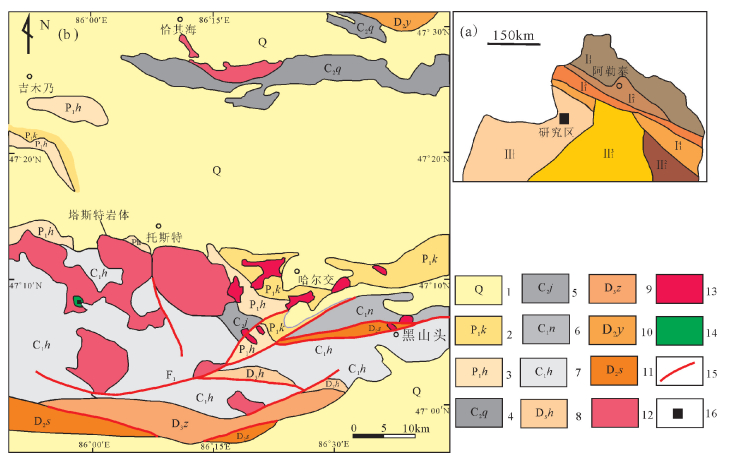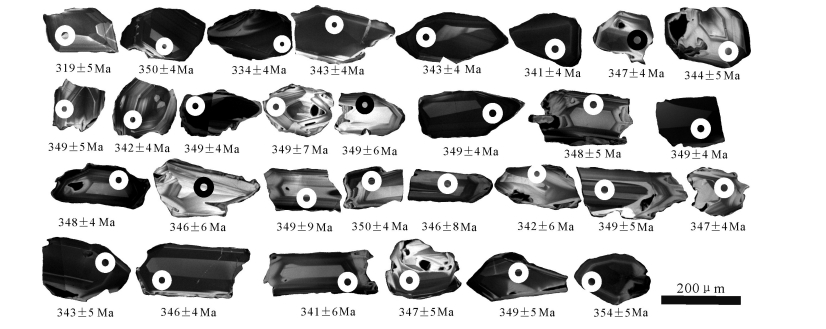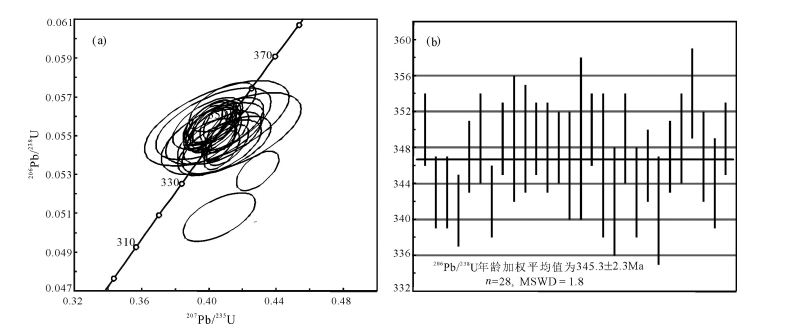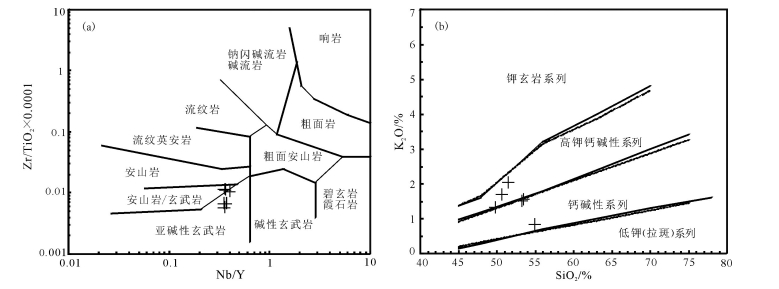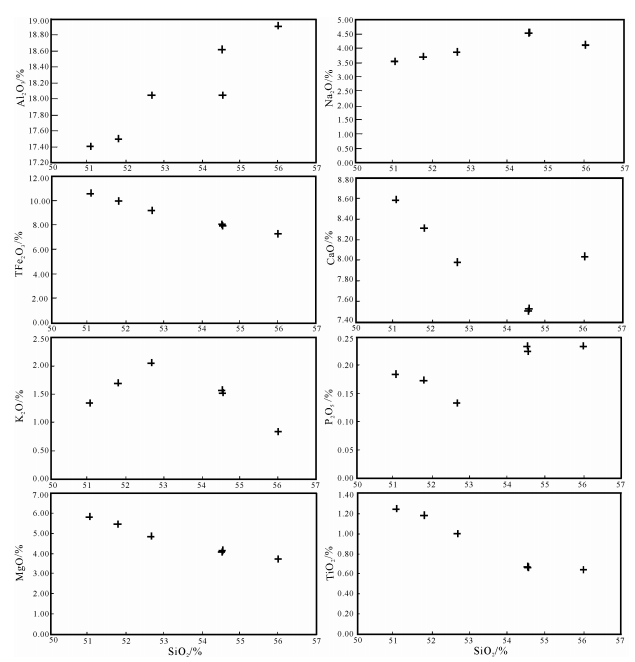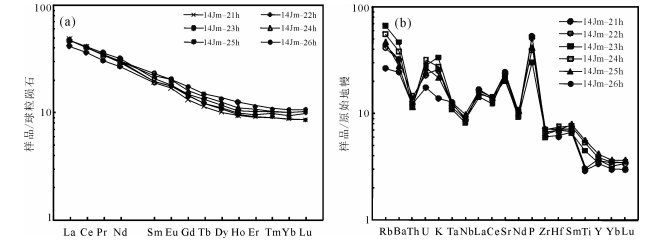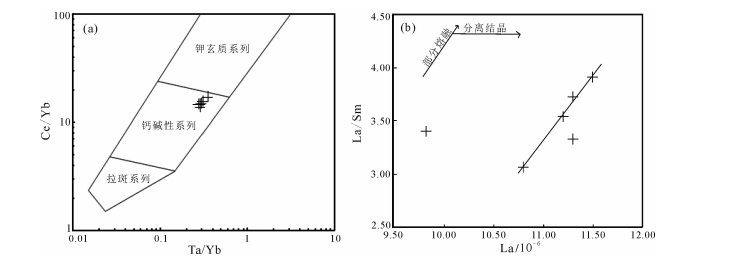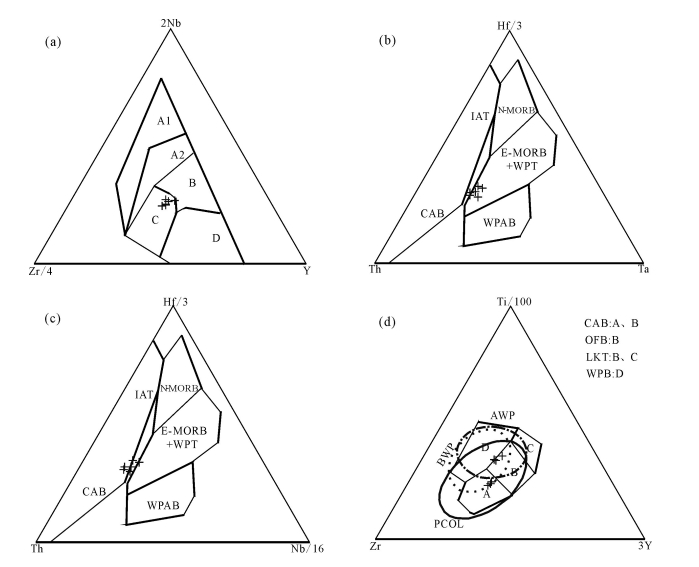Zircon U-Pb dating of Tasite gabbro in the north of West Junggar Basin and its geological implications
-
摘要:
西准噶尔北部萨吾尔地区晚古生代火山岩浆作用强烈,其形成构造环境一直是争议的焦点。塔斯特岩体作为区内最重要的复式岩体,主要由辉长岩、花岗闪长岩、二长花岗岩和钾长花岗岩组成,对其中的辉长岩进行LA-ICP-MS锆石U-Pb定年,206Pb/238U年龄加权平均值为345.3±2.3Ma(MSWD=1.8),说明塔斯特岩体形成于早石炭世中期。岩石地球化学特征显示,样品里特曼指数δ平均值为3.04,A/CNK(0.76~0.85) < 1.1,属于准铝质钙碱性岩石,岩石富集大离子亲石元素,而高场强元素和重稀土元素相对亏损,无明显的Eu异常,与西准噶尔地区后碰撞花岗岩类地球化学特征相似。综合研究认为,该辉长岩形成于后碰撞构造环境,可能是后碰撞阶段挤压-伸展转变期的产物。塔斯特辉长岩年龄是目前西准噶尔地区最老的后碰撞岩浆岩锆石年龄,表明西准噶尔地区在早石炭世中期已处于后碰撞构造环境,为西准噶尔地区后碰撞构造-岩浆演化下限的厘定提供了新的证据。
Abstract:The intrusions and volcanic rocks formed in Late Paleozoic are widespread in Sawuer area, the north of West Junggar, but the forming environment has been controversial. The Tasite pluton is an important multiple granitic intrusion which consists of gabbro, granodiorite, monzonite granite, K-feldspar granite and some other rocks. According to U-Pb age analysis, the formation age of the gabbro from the Tasite pluton is 345.3±2.3 Ma, suggesting the middle stage of Early Carboniferous. The geochemical studies indicate that the average of δ is 3.04, A/CNK ratios(0.76~0.85) is lower than 1.1, which belongs to papa-aluminum and calc-alkali rocks. This pluton is enriched in LILE (Rb, Sr, Ba, U, K), depleted in HFSE (Nb, Ta, T, Zr, Hf) and HREE (Yb, Y), with no Eu anomalies, which is similar to features of post-collisional magmatic rocks in West Junggar. It can be deduced that the gabbro might have formed in the extrusion to extension stage of the post-collisional period. The zircon U-Pb age of the Tasite pluton in this paper is the oldest age of post-collisional magmatic rocks in Junggar reported so far, thus providing a new evidence for confining the beginning time of post-collisional period in West Junggar.
-
花岗岩型铀矿床是中国重要的铀矿床类型,主要分布于华南地区,目前占中国已探明铀资源量的22.9%[1-6]。华南地区花岗岩型铀矿床主要产于花岗岩体内部或外接触带附近,受断裂构造控制[7-8]。鉴于其成因类型属于热液型铀矿床[9],因此成矿流体始终是探讨该地区铀成矿作用过程最重要和最直接的手段[10-13]。
桃山-诸广山铀成矿带位于南岭地区,是中国最大的花岗岩型铀成矿带[14],其预测资源量占整个花岗岩型铀矿床预测资源量的50%[6],长期以来一直是学者们关注的焦点[15-17]。长排矿区位于诸广山岩体南缘长江铀矿田中部,毗邻著名的棉花坑(302)铀矿床,被认为是桃山-诸广山铀成矿带最具找矿潜力的地区之一。前人对该矿区开展了大量的岩石学、年代学、找矿勘查等方面的研究工作[18-20],但关于成矿作用和成矿机制方面的研究则较少。众所周知,流体包裹体研究可以查明成矿流体性质和成矿物质沉积机制,是研究成矿作用和成矿机制的重要手段[21-24]。因此,本文选择长排矿区开展流体包裹体及同位素研究,通过查明成矿流体的性质并探讨其成矿机制,为总结区域成矿规律和找矿提供依据。
1. 区域及矿区地质特征
诸广山地区位于广东、湖南和江西三省交界处,以出露巨型诸广山花岗岩岩基为特点。诸广山花岗岩位于该区中部,产状受南岭东西向构造和诸广山南北向构造的联合控制[25]。诸广山花岗岩体主要为过铝质花岗岩,岩性有二云母花岗岩、黑云母花岗岩、二长花岗岩等。区内地层多分布于诸广山岩体边部,主要包括:震旦系、寒武系、奥陶系变质砂岩、泥岩;泥盆系、石炭系灰岩和砂岩;白垩系—新近系碎屑岩[26]。长江矿田位于诸广山地区中部,是中国重要的铀矿田之一。该矿田以出露白垩纪、侏罗纪和三叠纪花岗岩为主,几乎未见地层露头。区内构造由NE—SW向、NW—SE向、N—S向和E—W向断裂构造组成,由北向南还分布有NE— SW向的里周、棉花坑和黄溪水断裂及NW—SE向的油洞断裂4条区域性断裂(图 1)。
![]() 图 1 长江铀矿田及长排矿区地质图(据参考文献[26]修改)Figure 1. Geological map of the Changjiang Uranium ore district and Changpai area
图 1 长江铀矿田及长排矿区地质图(据参考文献[26]修改)Figure 1. Geological map of the Changjiang Uranium ore district and Changpai area长排矿区位于长江铀矿田中部,其北接棉花坑铀矿床,受油洞断裂控制(图 1)。区内出露的侵入岩体主要为油洞岩体和长江岩体,其次为中基性岩脉等。油洞岩体形成于印支期,岩性主要为中粒小斑状二云母花岗岩。长江岩体形成于燕山期,呈岩基状产出,岩性主要为中粒黑云母花岗岩,局部出露细粒不等粒黑云母花岗岩,与毗邻油洞岩体呈侵入接触。长排矿区铀矿化严格受断裂控制,矿体产于NW向油洞断裂及NNW向断裂中。矿区硅化、赤铁矿化、黄铁矿化、紫黑色萤石化等蚀变与矿化关系密切,且具有水平分带特征,即由构造带中心向外侧依次为硅化→赤铁矿化→绢云母化→粘土化。矿石矿物主要为沥青铀矿,多呈脉状、浸染状构造。根据矿物组合可将长排矿区矿化期次划分为成矿前期、成矿期和成矿后期。其中,成矿前期以形成白色石英脉为主要特点;成矿期主要形成灰色微晶石英沥青铀矿、红色微晶石英沥青铀矿、萤石、黄铁矿等;成矿后期主要为白色石英及少量萤石。
2. 样品采集及分析方法
2.1 样品特征
进行流体包裹体测温的10件样品分别采自长排矿区7号(ZK304- 3)、61号(ZK41- 1)和9号(ZK11-2,ZK223-1,ZK4-3)富矿带中,其中成矿期样品来自钻孔ZK11-2,ZK4-3,ZK41-1,是发育于蚀变花岗岩中的灰色-红色石英脉、紫黑色萤石脉;成矿后期样品来自钻孔ZK11- 2,ZK304- 3,ZK223-1,主要为淡绿(紫)色和白色方解石脉。硫同位素样品均采于长排矿区9号带南段的钻孔ZK11-2中。样品为产于不同深度含矿花岗岩中的成矿期黄铁矿,多为细粒结构、团块状构造。
2.2 流体包裹体显微测温和激光拉曼分析
流体包裹体显微测温工作在中国地质大学(北京)地球化学教研室流体包裹体实验室完成。测试仪器为LINK THMSGS 600型冷热台,显微测温采用标准物质(KNO3、K2CrO3、CCl4)及人工配制的NaCl标准溶液对仪器进行温度标定,测定温度范围为-196~600℃,测试环境始终保持在25℃左右。包裹体测定时选用的显微镜倍数为500倍,首先利用液氮对包裹体进行降温,并观察包裹体的变化,包裹体被冷冻后,缓慢升温,当接近相变点时,减慢升温速率至0.1℃/min,记录冰点温度;继续升温,观察相态变化,当接近相变点时,减慢升温速率至0.5℃/ min或1℃/min,记录笼形物消失温度、部分均一温度和完全均一温度。均一温度误差为1℃,冰点温度误差为0.1℃。NaCl-H2O体系盐度根据NaClH2O型流体包裹体在冰点与盐度关系表中查得[27],密度值根据经验公式计算求得[28]。
流体包裹体激光拉曼分析在核工业北京地质研究院分析测试所实验室进行,测试仪器为LABHR-VISLabRAM HR800型显微激光拉曼光谱仪,扫描范围为100~4200cm-1,波长为532nm,湿度为50%,测试环境为25℃。
2.3 硫同位素分析
硫同位素分析在核工业北京地质研究院分析测试中心完成。以Cu2O做氧化剂制备测试样品,仪器型号为Finnigan MAT-251型质谱仪,分析结果采用国际标准CDT表达,分析精度优于0.2‰。
3. 分析结果
3.1 流体包裹体岩相学特征
本次重点对成矿期和成矿后期的石英、萤石及方解石中的流体包裹体进行了岩相学观察和显微测温实验。根据室温下流体包裹体岩相学特征,可将原生包裹体分为2种类型:含CO2三相包裹体(Ⅰ型:VCO2 + LCO2 +LH2O)和气液两相包裹体(Ⅱ型:V+L)(图 2)。
Ⅰ型:含CO2三相包裹体(VCO2 + LCO2 +LH2O),室温下(25℃)可见到液相CO2围绕气泡呈环状分布,此类包裹体气相组分占15%~85%,主要形态为椭圆状、长条状,少数为不规则状,长轴为4~12μm,主要赋存在成矿期石英中,加热多数均一到气相。
Ⅱ型:气液两相包裹体(V+L),此类包裹体最发育,与其他类型包裹体共存。根据包裹体气液比,又可分为2个亚类型:Ⅱ-1型和Ⅱ-2型。Ⅱ-1型包裹体为富液相流体包裹体,气相组分占3%~30%,多为5%~15%,形态主要有椭圆形、长条形和不规则形,长轴为3~18μm,成群分布,均一化过程中多均一为液相。Ⅱ-2型包裹体为富气相流体包裹体,气相组分占50%~90%,形态多为椭圆形和多边形,长轴为3~10μm,呈孤立分布,均一化过程中多均一为气相。镜下观察显示,Ⅱ-1型包裹体比Ⅱ-2型包裹体更发育。
成矿后期包裹体主要以富液相流体包裹体(Ⅱ-1型)为主,气相组分占3%~30%,多为5%~10%,形态主要有椭圆形、近四边形和不规则形,长轴为4~19μm,个别可达40~50μm,属原生包裹体,在均一化过程中均一为液相。
3.2 流体包裹体显微测温和激光拉曼分析结果
在流体包裹体岩相学特征的基础上,对各类型流体包裹体进行显微测温工作。实验结果(表 1;图 3、图 4)显示,成矿期流体包裹体均一温度和盐度变化范围较大,分别为120~388℃和1.74% ~10.24% NaCleqv。其中,Ⅰ型流体包裹体初熔温度范围为-61.9~-58.9℃,其笼形物消失温度为5.5~8.2℃,部分均一温度为19.7~29.4℃,完全均一温度范围为291~388℃,盐度为3.52%~7.87% NaCleqv;Ⅱ-1型包裹体均一温度范围为113~356℃,主要集中在120~280℃范围,盐度为1.74% ~10.24% NaCleqv;Ⅱ-2型包裹体均一温度范围为222~378℃,盐度为3.23%~7.02% NaCleqv。成矿后期的原生Ⅱ-1型富液相流体包裹体均一温度范围为80~179℃,主要集中在120~170℃,盐度为0.35%~6.3% NaCleqv。
表 1 长排矿区流体包裹体显微测温结果Table 1. The temperature determination of fluid inclusions at Changpai成矿期次 包裹体类型 测试
数目CO2包裹体 均一温度/℃ 冰点/℃ 盐度/%NaCleqv 初溶温度/℃ 笼形物消失温度/℃ 部分均一温度/℃ 范围 平均 范围 平均 成矿期 I 17 -61.9~-58.9 5.5~8.2 19.7~29.4 291~388 338 - 3.52~7.87 5.40 Ⅱ-1 149 - - - 113~356 199 -6.8~-1 1.74~10.24 5.52 Ⅱ-2 12 - - - 222~378 314 -4.4~-1.9 3.23~7.02 4.63 成矿后期 Ⅱ-1 56 - - - 80~179 134 -3.9~-0.2 0.35~6.3 3.8 本文对成矿期流体包裹体的气相组分进行了激光拉曼分析。分析结果显示(图 5),成矿期Ⅱ-1型富液相两相水溶液包裹体气相组分主要为CO2、CH4和H2,Ⅱ-2型富气相两相水溶液包裹体气相组分主要为CO2。
3.3 硫同位素组成
本次共测定了成矿期4件黄铁矿的硫同位素组成(表 2),4件样品均采于长排矿区9号带南段的钻孔ZK11-2中。结果显示,黄铁矿的硫同位素组成变化范围不大,δ34S值在-10.2‰~-3.2‰之间。
表 2 长排矿区黄铁矿硫同位素组成Table 2. S isotopic compositions of the pyrite from the Changpai area序号 样号 矿物 δ34s/‰ 岩石名称 1 GZN201-3 黄铁矿 -9.1 产于灰色微晶石英脉屮 2 GZN201-1 黄铁矿 -3.2 产于灰色微晶石英脉屮 3 GZN201-11 黄铁矿 -9.7 产于猪肝色赤铁矿化蚀变花岗岩屮 4 ZK11-2-2 黄铁矿 -10.7 产于肉红色微晶硅质脉屮 4. 讨论
4.1 成矿流体性质
根据包裹体显微测温结果(表 1;图 3),可将长排矿区成矿期流体包裹体划分为2组。第1组为含CO2三相(Ⅰ型)和富气相包裹体(Ⅱ-2型),均一温度主要集中在300~400℃,盐度为3.2% ~7.9% NaCleqv。第2组主要为富液相包裹体(Ⅱ-1型),均一温度范围主要集中在140~260℃,盐度为1.74%~ 10.24% NaCleqv。由此可知,根据流体包裹体岩相学特征和显微测温结果,长排矿区的成矿期流体可分为2组,第1组具有中高温、中高盐度的特点,以含CO2三相和富气相包裹体为主,表现出岩浆水的特征,而第2组为中低温、中高盐度流体,以富液相流体包裹体为主,表现出大气水的特征。激光拉曼分析结果显示(图 5),长排矿区成矿流体含有CO2、CH4、H2等气相成分。其中,第1组包裹体中的Ⅱ-2型包裹体气相组分主要为CO2;第2组包裹体中的Ⅱ-1型包裹体气相组分主要为CO2、CH4和H2。此外,测温实验结果显示(表 1),第1组包裹体中的Ⅰ型流体包裹体初熔温度范围为-61.9~-58.9℃,低于其三相点温度-56.6℃,说明流体包裹体中应该存在CH4等气体。关于CO2气体的来源问题,华南花岗岩型铀矿床成矿流体中的CO2属地幔来源,是白垩纪—新近纪地壳拉张期间,由地幔去气作用或幔源基性岩浆侵入提供而不是来自于产铀花岗岩体[10]。综上所述,长排矿区的成矿流体可能主要为岩浆水和大气水,以含有CO2、CH4、H2等气相成分为特征。
本次研究对与成矿有关的石英和萤石进行了流体包裹体测温,所测温度代表了成矿期流体的温度范围。这一温度范围(120~400℃)与铀氧化物溶解的最大温度区间[29-31]基本一致。由上文可知,长排矿区成矿流体分为中高温(300~400℃)和中低温(140~260℃)2组。然而,中高温流体温度范围明显高于华南地区花岗岩型铀矿床的铀成矿温度范围(120~260℃)[32],但是与角砾状沥青铀矿成矿流体的温度范围基本一致(290~345℃)[31]。由此,考虑到长排矿区绝大部分成矿期流体包裹体均一温度范围(140~294℃;图 3)与华南地区花岗岩型铀矿床的铀成矿温度范围(120~260℃)[32]一致,以及华南地区铀矿床普遍发育角砾状沥青铀矿[31],笔者建议将长排矿区成矿流体划分为成矿期早阶段流体(300~ 400℃)和成矿期晚阶段流体(140~260℃)。其中,成矿期晚阶段流体最重要。这种成矿流体具有中高温和中低温2种情况的现象在华南地区其他矿床也有报道,如棉花坑矿床成矿流体划分为中高温(290~310℃)流体和中低温(140~270℃)流体,并指出这2种流体分别代表了早、晚2次成矿作用[31]。另外,根据粤北下庄铀矿田包裹体研究结果,指出该矿床成矿期存在2种不同来源流体[33],一种为高温(270~320℃)中等盐度岩浆流体;另一种为中低温(120~160℃)低盐度壳源流体。这一现象很可能说明长排矿区成矿期存在不同流体的混合。
4.2 成矿机制初探
根据成矿期黄铁矿的硫同位素分析结果(表 2)可知,δ34S值范围在-10.2‰~-3.2‰之间,含铀花岗岩的硫同位素范围[34],亦与华南地区其他铀矿床,如湖南340、380和广西376等铀矿床的硫同位素范围基本一致(δ34S=-9.36‰~-3.35‰)[35],反映了长排矿区硫化物的硫同位素组成受围岩制约的特点。强过铝质富铀花岗岩常被认为是华南地区重要的铀源岩[5, 12, 36-37],其形成与古元古代晚期—中元古代早期富铀基底部分熔融关系密切[5, 38-39]。最近研究显示,华南地区的富铀基底可能是在古元古代晚期之后(约2.2Ga)含铀矿物在浅海中沉积形成[12],而后期的构造-岩浆活动使这些古老沉积岩中的U在花岗岩中不断富集,进而导致花岗岩成为重要的铀源岩[34, 39-40]。长排矿区的铀矿化主要产于区内的长江岩体和油洞岩体中。元素地球化学特征和Sr-Nd同位素组成显示,长江岩体和油洞岩体的原岩分别为砂质岩和泥岩,是古元古代晚期基底(2.0~1.8Ga)部分熔融的产物[18-19],与南岭地区产铀花岗岩的特征[38, 41]基本一致。因此,结合成矿期黄铁矿硫同位素组成特征,本文认为长排矿区成矿流体中的U应主要来源于区内古老含铀地层部分熔融形成的花岗岩。
实验研究表明,U常与O结合成UO22+,进而和OH-、CO32-、SO42-、Cl-、F-等组成络合物在流体中运移[42]。长排矿区的铀矿化主要与硅化、赤铁矿化、黄铁矿化及紫黑色萤石化等蚀变密切相关,而且成矿流体具有中高盐度及富CO2、CH4、H2等气相成分的特点(图 4、图 5)。这说明,该区成矿流体中的U很可能与CO32-、F-、Cl-等结合成络合物进行运移和富集。在温度-盐度图解(图 4)中,第2组流体相对于第1组流体具有较低的均一温度及较大的盐度变化范围,说明成矿期晚期流体很可能发生了流体的混合作用。众所周知,降温、减压及流体的混合会导致U的CO32-、F-及Cl-络合物水解,进而使U发生沉淀[43]。因此,长排矿区U的沉淀很可能与流体温度的降低和流体的混合作用有关。此外,成矿后期流体包裹体均一温度和盐度明显低于成矿期流体(图 4),说明成矿物质卸载沉淀之后,流体温度继续降低,并形成淡(紫)绿色萤石、方解石等矿物。
大量证据表明,华南地区富铀花岗岩主要为印支期花岗岩,而且印支期花岗岩的成矿部位常见到燕山期岩浆作用的叠加[12, 37]。研究表明,华南地区燕山期大规模的铀矿化与华南和华北地块后碰撞及太平洋板块俯冲引起的岩石圈伸展有关[1]。岩石圈的伸展形成了大规模的断裂构造,不仅有利于花岗质岩浆的侵入和CO2等气体的上升[3],还为大气水的下渗提供了有利条件。长排矿区在印支期和燕山期发生了2期岩浆作用,分别形成了油洞岩体(232±4Ma)[18]和长江岩体(161.6±2.1Ma)[19],矿体即赋存于这些花岗岩岩体的断裂破碎带中。因此,结合区域地质背景可将长排矿区铀成矿作用机制初步概括为,①在印支期后碰撞和燕山期板块俯冲导致的伸展背景下,古元古代基底部分熔融形成岩浆,并沿深大断裂上侵,先后形成富铀的油洞岩体和长江岩体;②富含CO2、CH4、H2等的岩浆水与大气水可能沿油洞岩体和长江岩体内的断裂及裂隙淋滤出大量的U;③U以UO22+的形式与OH-、CO32-等组成络合物在成矿流体运移;④随着成矿流体温度的降低及流体混合作用的发生,U的络合物发生水解并沉淀,形成灰色微晶石英沥青铀矿、红色微晶石英沥青铀矿、萤石和黄铁矿等矿物。
5. 结论
(1)长排矿区成矿期流体包裹体可分为2组,气相成分主要为CO2、CH4和H2等。第1组均一温度主要在291~388℃之间,盐度为3.2%~7.9%NaCleqv,属Ⅰ型含CO2三相和Ⅱ-2型富气相包裹体。第2组均一温度为140~260℃,盐度为1.74% ~10.24% NaCleqv,属Ⅱ-1型富液相包裹体。
(2)长排矿区成矿流体中的U应主要来源于古老含铀地层部分熔融形成的富铀花岗岩。
(3)结合区域地质及地球化学特征可知,长排矿区铀成矿作用很可能形成于岩石圈伸展的背景下,温度的降低和流体的混合作用可能是导致U质沉淀的重要因素。
致谢: 野外工作期间得到中国地质调查局西安地质调查中心陈隽璐研究员的大力指导,数据处理阶段得到长安大学葛家昆师兄、徐倩、王金雅师姐和西安地质调查中心王红杰的大力帮助,张瑜师兄和西安地质调查中心陈向阳高级工程师在成文过程中提出了宝贵意见和建议,在此一并表示衷心感谢。 -
图 1 新疆西准噶尔北部萨吾尔地区地质简图(据参考文献[2-4]修改)
Ⅰ—西伯利亚板块;Ⅰ1—阿尔泰古生代大陆边缘;Ⅰ11—北阿尔泰早古生代非岩浆型被动陆缘;Ⅰ12—南阿尔泰泥盆纪岩浆型被动陆缘;Ⅰ13—额尔齐斯构造混杂带;Ⅰ14—北准噶尔泥盆纪洋内弧;Ⅱ—哈萨克斯坦-准噶尔板块;Ⅱ1—准噶尔板块及大陆边缘;Ⅱ11—西准噶尔古生代弧盆系;Ⅱ12—东准噶尔古生代弧盆系;Ⅱ13—准噶尔坳陷;1—第四系;2—二叠系卡拉岗组;3—二叠系哈尔加乌组;4—石炭系恰其海组;5—石炭系吉木乃组;6—石炭系那林卡拉组;7—石炭系黑山头组;8—泥盆系洪古勒愣组;9—泥盆系朱鲁木特组;10—泥盆系蕴都卡拉组;11—泥盆系萨吾尔山组;12—花岗岩;13—花岗斑岩;14—辉长岩;15—断裂;16—测年样品采样位置;F1—萨吾尔断裂
Figure 1. Sketch geological map of Sawuer area in the north of West Junggar, Xinjiang
图 4 塔斯特岩体Nb/Y-Zr/TiO2岩石分类图(a) (据参考文献[31])和SiO2-K2O图(b)
Figure 4. Nb/Y-Zr/TiO2 (a) and SiO2-K2O diagrams (b) of Tasite pluton
图 6 塔斯特岩体球粒陨石标准化稀土元素配分型式(a)和原始地幔标准化微量元素蜘蛛网图(b)(标准化值根据参考文献[30])
Figure 6. Chondrite-normalized REE patterns (a)and primitive mantle-normalized spider diagrams (b) for Tasite Pluton
图 7 塔斯特辉长岩Ta/Yb-Ce/Yb(a,据参考文献[33])和La-La/Sm图解(b)
Figure 7. Ta/Yb-Ce/Yb (a) and La-La/Sm (b) diagrams for Tasite pluton
图 8 塔斯特辉长岩构造环境判别图解(据参考文献[41-43])
A1—板内碱性玄武岩;A2—板内拉斑玄武岩和拉斑玄武岩;B—富集型洋脊玄武岩和拉斑质板内玄武岩;C—板内玄武岩和火山弧玄武岩;D—正常洋脊玄武岩和火山弧玄武岩;CAB—火山弧钙碱性玄武岩;OFB—大洋溢流玄武岩;LKT—火山弧低钾拉斑玄武岩;WPB—板内玄武岩;N—MORB—正常洋中脊玄武岩;E-MORB+WPT—富集洋中脊玄武岩+板内拉斑玄武岩;WPAB—板内碱性玄武岩;IAT—岛弧拉斑玄武岩(Hf/Th>3.0);AWP—变薄了的大陆板内玄武岩;BWP—弧后变薄了的大陆岩石圈玄武岩;PCOL—后碰撞构造背景的玄武岩
Figure 8. Tectonic discrimination diagrams for Tasite pluton
表 1 萨吾尔山塔斯特岩体中辉长岩锆石U-Th-Pb同位数分析数据
Table 1 Zircon U-Th-Pb isotopic data for Tasite pluton in Sawuer area
测试点 Pb 232Th 238U Th/U 207Pb/206Pb 207Pb/235U Pb/206U238 208Pb/232Th 206Pb/238U 10-6 比值 1σ 比值 1σ 比值 1σ 比值 1σ 年龄/Ma 1σ 044CB02 25 472 296 1.59 0.0529 0.0008 0.407 0.007 0.0558 0.0007 0.0159 0.0003 350 4 046CB04 22 441 249 1.77 0.0539 0.0009 0.406 0.007 0.0547 0.0007 0.0167 0.0003 343 4 047CB05 34 689 404 1.71 0.0540 0.0008 0.407 0.006 0.0546 0.0007 0.0160 0.0003 343 4 048CB06 18 321 217 1.48 0.0545 0.0009 0.408 0.007 0.0543 0.0007 0.0155 0.0003 341 4 052CB07 16 274 192 1.43 0.0541 0.0010 0.412 0.007 0.0553 0.0007 0.0165 0.0004 347 4 053CB08 8 86 108 0.80 0.0522 0.0013 0.401 0.010 0.0557 0.0008 0.0173 0.0008 349 5 054CB09 14 216 184 1.18 0.0547 0.0011 0.411 0.008 0.0545 0.0007 0.0165 0.0005 342 4 055CB10 16 206 218 0.94 0.0530 0.0011 0.407 0.008 0.0557 0.0007 0.0180 0.0006 349 4 056CB11 11 152 154 0.99 0.0526 0.0031 0.403 0.023 0.0556 0.0012 0.0155 0.0017 349 7 057CB12 2 11 24 0.44 0.0535 0.0021 0.409 0.015 0.0556 0.0009 0.0169 0.0013 349 6 059CB13 39 830 428 1.94 0.0521 0.0008 0.399 0.006 0.0556 0.0007 0.0169 0.0003 349 4 060CB14 5 58 76 0.76 0.0526 0.0015 0.402 0.011 0.0554 0.0008 0.0168 0.0009 348 5 061CB15 9 123 130 0.95 0.0528 0.0012 0.403 0.009 0.0554 0.0007 0.0176 0.0006 348 4 062CB16 3 28 48 0.59 0.0532 0.0026 0.404 0.019 0.0551 0.0010 0.0167 0.0020 346 6 063CB17 6 52 82 0.63 0.0528 0.0039 0.405 0.028 0.0557 0.0015 0.0198 0.0027 349 9 064CB18 8 81 105 0.77 0.0523 0.0012 0.401 0.009 0.0558 0.0007 0.0175 0.0007 350 4 068CB19 5 51 68 0.75 0.0545 0.0038 0.413 0.027 0.0551 0.0014 0.0139 0.0021 346 8 069CB20 6 69 81 0.85 0.0547 0.0024 0.411 0.018 0.0545 0.0010 0.0161 0.0013 342 6 070CB21 12 148 157 0.94 0.0522 0.0019 0.399 0.014 0.0557 0.0009 0.0183 0.0011 349 5 071CB22 20 342 227 1.50 0.0529 0.0016 0.399 0.011 0.0547 0.0008 0.0159 0.0007 343 5 072CB23 26 440 334 1.32 0.0539 0.0009 0.409 0.007 0.0552 0.0007 0.0169 0.0004 346 4 073CB24 5 51 63 0.81 0.0543 0.0023 0.407 0.016 0.0544 0.0009 0.0201 0.0014 341 6 075CB25 15 230 190 1.21 0.0523 0.0011 0.399 0.008 0.0554 0.0007 0.0160 0.0005 347 4 076CB26 6 72 84 0.86 0.0522 0.0013 0.400 0.010 0.0556 0.0007 0.0167 0.0007 349 5 077CB27 14 213 164 1.30 0.0525 0.0017 0.408 0.013 0.0565 0.0008 0.0178 0.0009 354 5 078CB28 9 110 112 0.98 0.0530 0.0014 0.403 0.010 0.0553 0.0007 0.0172 0.0007 347 5 079CB29 6 79 90 0.87 0.0540 0.0021 0.408 0.015 0.0549 0.0009 0.0193 0.0013 344 5 080CB30 18 297 225 1.32 0.0526 0.0010 0.402 0.007 0.0556 0.0007 0.0168 0.0004 349 4 表 2 萨吾尔山塔斯特辉长岩全岩主量、微量和稀土元素分析结果
Table 2 Major, trace and rare earth elements of Tasite pluton in sawuer area
样品号 14Jm-21h 14Jm-22h 14Jm-23h 14Jm-24h 14Jm-25h 14Jm-26h SiO2 54.88 53.25 51.44 50.63 49.74 53.40 TiO2 0.63 0.65 0.98 1.16 1.22 0.66 Al2O3 18.54 18.24 17.63 17.11 16.96 18.24 Fe2O3 3.61 4.18 4.75 5.02 5.35 4.10 FeO 3.58 3.62 4.26 4.74 4.99 3.84 MnO 0.15 0.15 0.16 0.17 0.18 0.15 MgO 3.67 4.07 4.76 5.36 5.70 4.01 CaO 7.88 7.36 7.80 8.13 8.37 7.36 Na2O 4.03 4.43 3.78 3.63 3.46 4.44 K2O 0.82 1.49 2.01 1.66 1.31 1.54 P2O5 0.23 0.22 0.13 0.17 0.18 0.23 烧失量 1.95 2.28 2.28 2.20 2.52 2.03 总计 99.97 99.94 99.98 99.98 99.98 100.00 Mg# 64.63 66.71 66.57 66.84 67.06 65.05 A/NK 2.47 1.98 2.10 2.20 2.39 2.03 A/CNK 0.85 0.79 0.78 0.76 0.76 0.82 K2O+Na2O 4.95 6.06 5.93 5.41 4.89 6.10 K2O/Na2O 0.20 0.34 0.53 0.46 0.38 0.35 TFe2O3 7.74 8.40 9.71 10.52 11.18 8.54 Cu 23.20 12.30 12.10 15.00 19.30 10.80 Pb 6.10 3.75 5.10 5.78 5.22 4.68 Zn 59.40 56.90 65.30 72.90 75.30 55.70 Cr 57.40 57.50 57.80 55.40 56.70 59.50 Ni 21.30 24.90 26.20 27.40 27.10 23.00 Co 21.30 22.50 28.10 31.20 33.50 22.10 Li 5.47 8.62 11.20 12.60 12.20 7.93 Rb 17.00 26.20 42.00 35.10 30.00 27.90 Cs 0.44 0.62 0.63 0.62 0.63 0.60 Mo 0.36 0.51 0.66 0.59 0.72 0.48 Sr 516.00 496.00 454.00 433.00 434.00 500.00 Ba 172.00 224.00 330.00 266.00 197.00 226.00 V 138.00 152.00 238.00 276.00 306.00 152.0 Sc 17.10 18.90 28.90 33.80 36.30 20.40 Nb 6.22 6.08 5.84 6.24 6.95 6.00 Ta 0.52 0.50 0.45 0.50 0.52 0.48 Zr 68.70 74.50 66.50 78.70 71.80 79.30 Hf 1.87 2.17 1.94 2.31 2.18 2.22 Ga 19.60 19.50 19.40 19.90 20.10 20.40 U 0.37 0.48 0.59 0.67 0.57 0.49 Th 1.04 1.24 1.00 1.05 0.98 1.20 La 11.50 11.30 9.83 11.30 10.80 11.20 Ce 25.10 25.10 22.10 25.20 24.80 25.20 Pr 3.24 3.37 2.91 3.27 3.31 3.42 Nd 13.90 13.60 12.60 13.80 14.20 14.90 Sm 2.94 3.03 2.89 3.39 3.52 3.16 Eu 0.98 1.03 1.02 1.17 1.18 1.06 Gd 2.72 2.98 2.90 3.31 3.60 3.06 Tb 0.42 0.46 0.45 0.53 0.56 0.50 Dy 2.56 2.81 2.76 3.20 3.47 2.98 Ho 0.53 0.56 0.54 0.63 0.70 0.59 Er 1.50 1.59 1.53 1.79 1.92 1.68 Tm 0.23 0.25 0.23 0.26 0.28 0.26 Yb 1.46 1.60 1.48 1.72 1.80 1.71 Lu 0.22 0.25 0.22 0.26 0.27 0.26 Y 15.40 16.60 15.60 17.70 19.20 16.60 ΣREE 67.3 67.93 61.46 69.83 70.41 69.98 LREE 57.66 57.43 51.35 58.13 57.81 58.94 HREE 9.64 10.50 10.11 11.70 12.60 11.04 LREE/HREE 5.98 5.47 5.08 4.97 4.59 5.34 LaN/YbN 5.65 5.07 4.76 4.71 4.30 4.70 δEu 1.04 1.04 1.07 1.05 1.00 1.03 注:Mg#=100×18×MgO /(18×MgO+18×FeO); A/CNK(摩尔比)=Al2O3/(Na2O+K2O+CaO); A/NK(摩尔比)=Al2O3/(Na2O+K2O); TFe2O3= Fe2O3+1.111×FeO; 球粒陨石标准化值据参考文献[30]; δEu =EuN /(SmN+GdN)1/2; 主量元素单位为%,微量和稀土元素单位为10-6 -
李锦轶.新疆东部古元古代晚期和古生代构造格架及其演变[J].地质评论, 2004, 50(3):304-322. http://www.oalib.com/paper/4886722 李锦轶, 何国琦, 徐新, 等.新疆北部及邻区地壳构造格架及其形成过程的初步探讨[J].地质学报, 2006, 80(1):148-168. doi: 10.3321/j.issn:0001-5717.2006.01.017 肖文交, 韩春明, 袁超, 等.新疆北部石炭纪—二叠纪独特的构造-成矿作用:对古亚洲洋构造域南部大地构造演化的制约[J].岩石学报, 2006, 22(5):1062-1076. http://www.ysxb.ac.cn/ysxb/ch/reader/create_pdf.aspx?file_no=200605113&journal_id=ysxb&year_id=2006 Xiao W J, Han C M, Yuan C, et al. Middle Cambrian to Permian subduction-related accretionary orogenesis of northern Xinjiang, NW China: Implications for the tectonic evolution of central Asia[J]. Journal of Asian Earth Sciences, 2008, 32: 102-117. doi: 10.1016/j.jseaes.2007.10.008
何国琦, 李茂松, 刘德权, 等.中国新疆古生代地壳演化及成矿[M].香港:香港文化教育出版社, 1994: 1-437. 何国琦, 刘德权, 李茂松, 等.新疆主要造山带地壳发展的五阶段模式及成矿系列[J].新疆地质, 1995, 13(2):99-194. http://industry.wanfangdata.com.cn/dl/DetailCorrelated/Reference?id=xjdz201104010&title=%25e8%25a5%25bf%25e5%25a4%25a9%25e5%25b1%25b1%25e6%259c%25a8%25e6%259c%25ad%25e5%25b0%2594%25e7%2589%25b9%25e5%25b2%25a9%25e7%25be%25a4%25e5%259c%25b0%25e7%2590%2583%25e5%258c%2596%25e5%25ad%25a6%25e4%25b8%258e%25e5%258f%2598%25e5%25bd%25a2%25e5%258f%2598%25e8%25b4%25a8%25e7%2589%25b9%25e5%25be%2581%25e5%258f%258a%25e6%259e%2584%25e9%2580%25a0%25e6%25bc%2594%25e5%258c%2596&resourceType=Periodical 徐学义, 李荣社, 陈隽璐, 等.新疆北部古生代构造演化的几点认识[J].岩石学报, 2014, 30(6):1521-1534. http://www.ysxb.ac.cn/ysxb/ch/reader/create_pdf.aspx?file_no=20140601&journal_id=ysxb&year_id=2014 涂光炽.初议中亚成矿域[J].地质科学, 1999, 34(1):397-404. http://www.cqvip.com/QK/94066X/1999004/3690707.html 王京彬, 徐新.新疆北部后碰撞构造演化与成矿[J].地质通报, 2006, 25(1):23-31. http://www.wanfangdata.com.cn/details/detail.do?_type=perio&id=dizhixb200601003 韩宝福, 季建清, 宋彪, 等.新疆准噶尔晚古生代陆壳垂向生长(Ⅰ)——后碰撞深成岩浆活动的时限[J].岩石学报, 2006, 22 (5):1077-1086. http://www.ysxb.ac.cn/ysxb/ch/reader/view_abstract.aspx?file_no=200605114 袁峰, 周涛发, 谭绿贵, 等.西准噶尔萨吾尔地区I型花岗岩同位素精确定年及其意义[J].岩石学报, 2006, 22(5):1238-1248. http://www.wanfangdata.com.cn/details/detail.do?_type=perio&id=ysxb98200605015 范裕, 周涛发, 袁峰, 等.新疆西准噶尔地区塔斯特岩体锆石LAICPMS年龄及其意义[J].岩石学报, 2007, 23(8):1901-1908. http://industry.wanfangdata.com.cn/dl/Detail/Periodical?id=Periodical_ysxb98200708011 王红杰, 陈隽璐, 白建科, 等.西准噶尔北部萨吾尔山后碰撞花岗闪长岩LA-ICP-MS锆石U-Pb定年及其地质意义[J].西北地质, 2016, 49(2):93-104. http://www.cqvip.com/QK/93232X/201602/668983990.html 高睿, 肖龙, 王国灿, 等.西准噶尔晚古生代岩浆活动和构造背景[J].岩石学报, 2013, 29(10):3413-3434. http://www.ysxb.ac.cn/ysxb/ch/reader/create_pdf.aspx?file_no=20131008&journal_id=ysxb&year_id=2013 陈家富, 韩宝福, 张磊, 等.西准噶尔北部晚古生代两期侵入岩的地球化学、Sr-Nd同位素特征及其地质意义[J].岩石学报, 2010, 26(8):2317-2335. http://www.ysxb.ac.cn/ysxb/ch/reader/view_abstract.aspx?file_no=20100808 尹继元, 陈文, 袁超, 等.新疆西准噶尔晚古生代侵入岩的年龄和构造意义:来自锆石LA-ICPMS定年的证据[J].地球化学, 2013, 42(5):414-429. http://d.wanfangdata.com.cn/Periodical_dqhx201305003.aspx 周刚.吉木乃县塔斯特岩体地质地球化学特征及含矿性评价[J].新疆地质, 2000, 18(1):79-84. http://www.cnki.com.cn/Journal/A-A5-XJDI.htm 刘伟, 赵志忠.新疆乌仑古-斋桑泊构造带晚古生代花岗岩类的稀土元素分布模式[J].大地构造与成矿学, 1995, 19(2):133-144. http://www.cqvip.com/QK/90781X/199502/1705738.html 张达玉, 周涛发, 袁峰, 等.西准噶尔萨吾尔地区早古生代火山岩的发现及其意义[J].岩石学报, 2015, 31(2):415-425. http://www.wanfangdata.com.cn/details/detail.do?_type=perio&id=ysxb98201502009 周涛发, 袁锋, 谭绿贵, 等.新疆萨吾尔地区晚古生代岩浆作用的时限、地球化学特征及地球动力学背景[J].岩石学报, 2006, 22 (5):1225-1237. http://kns.cnki.net/KCMS/detail/detail.aspx?filename=ysxb200605014&dbname=CJFD&dbcode=CJFQ 周涛发, 袁峰, 张达玉, 等.新疆西准噶尔塔北地区晚古生代中酸性侵入岩的成因分析[J].岩石学报, 2015, 31(2):351-370. https://www.researchgate.net/profile/Yufeng_Deng/publication/279331549_Genesis_of_the_granitoids_intrusions_in_Tabei_area_West_Junggar_Northwest_China_Evidences_from_geological_and_geochemcal_characteristics/links/5688e95e08ae1e63f1f8af48.pdf?origin=publication_detail Zhou TF, Yuan F, Fan Y, et al. Granites in the Saur region of the west Junggar, Xinjiang Province, China: Geochronological and geochemical characteristics and their geodynamic significance[J]. Lithos, 2008, 106: 191-206. doi: 10.1016/j.lithos.2008.06.014
韩宝福, 郭召杰, 何国琦, "钉合岩体"与新疆北部主要缝合带的形成时限[J].岩石学报, 2010, 26(8):2233-2246. http://industry.wanfangdata.com.cn/dl/Detail/Periodical?id=Periodical_ysxb98201008001 Zhou T F, Tan L G, Fan Y, et al. SHRIMP U-Pb zircon age of the Kaerjiao intrusion in the Sawuer region in West Junggar, Xinjiang[J]. Acta Geologica Sinica, 2007, 81(2): 322-329. doi: 10.1111/acgs.2007.81.issue-2
Yin J Y, Yuan C, Sun M, et al. Late Carboniferous high-Mg dioritic dikes in western Junggar, NW China: Geochemical features, petrogenesis and tectonic implications[J]. Gondwana Research, 2010, 17(1): 145-152. doi: 10.1016/j.gr.2009.05.011
Kosler J, Fonneland H, Sylvester P, et al. U-Pb dating of detrital zircons for sediment provenance studies-acoparison of laser ablation LCPMS and SIMS techniques[J]. Chemical Geology, 2002, 182: 605-618. doi: 10.1016/S0009-2541(01)00341-2
袁洪林, 吴福元, 高山, 等.东北地区新生代侵人体的锆石激光探针U-Pb年龄测定与稀土元素成分分析[J].科学通报, 2003, 48 (2):2411-2421. http://www.wanfangdata.com.cn/details/detail.do?_type=perio&id=kxtb200314008 吴元保, 郑永飞.锆石成因矿物学研究及其对U-Pb年龄解释的制约[J].科学通报, 2004, 49(16):1589-1604. doi: 10.3321/j.issn:0023-074X.2004.16.002 Compston W, Williams I S, Kirschvink J K, et al. Zircon U-Pb ages for the Early Cambrian time-scale[J]. Journal of Geological Society of London, 1992, 149: 171-184. doi: 10.1144/gsjgs.149.2.0171
Sun S S, McDonough W E. Chemical and isotopic systematics of oceanic basalts: Implicaitons for mantle composition and processes[C]//Saunders A D, Norry M J. Magmatism in the Ocean Basins. Geological Society of London, Special Publication, 1989, 42: 13-345. https://academic.oup.com/petrology
Winchester J A, Floyd P A. Geochemical discrimination of different magma series and their differentiation products using immobile elements[J]. Chemical Geology, 1977, 20: 325-343. doi: 10.1016/0009-2541(77)90057-2
杨高学, 李永军, 李注苍, 等.东准噶尔东北缘后碰撞火山岩成因与构造环境[J].地学前缘, 2010, 17(1):49-60. http://www.wanfangdata.com.cn/details/detail.do?_type=perio&id=dxqy201001004 Müller D, Groves D I. Potassic Igneous Rocks and Associated Gold-Copper Mineralization[J]. Berlin: Springer Verlag, 1995: 1-144. https://link.springer.com/content/pdf/bfm:978-3-642-59665-0/1.pdf
Shen P, Shen Y C, Liu T B, et al. Genesis of volcanic-hosted gold deposits in the Sawur gold belt, northern Xinjiang, China: Evidence from REE, stable isotopes, and noble gas isotopes[J]. Ore Geology Reviews, 2007, 32(1/2): 207-226. https://www.sciencedirect.com/science/article/pii/S0169136806001259
Rapp R P, Watson E B. Dehydration melting of metabasalt at 8~ 32 kbar: Implications for continental growth and crust-mantle recycling[J]. Journal of Petrology, 1995, 36: 891-931. doi: 10.1093/petrology/36.4.891
董国臣, 莫宣学, 赵志丹, 等.西藏冈底斯南带辉长岩及其所反映的壳幔作用信息[J].岩石学报, 2008, 24(2):203-210. http://www.wanfangdata.com.cn/details/detail.do?_type=perio&id=ysxb98200802002 Chen B, Jahn B M. Genesis of post-collisional granitoids and basement nature of the Junggar Terrane, NW China: Nd-Sr isotope and trace element evidence[J]. Journal of Asian Earth Sciences, 2004, 23: 691-703. doi: 10.1016/S1367-9120(03)00118-4
Han B F, He G Q, Wang S Q. Post collision mantle genesis magma activity, bottom uplifting and character of Zhungeer basin basement[J]. Science in China (Series D), 1999, 299(1): 16-21. doi: 10.1007/s11430-005-0121-7.pdf
赵泽辉, 郭召杰, 韩宝福, 等.新疆三塘湖盆地古生代晚期火山岩地球化学特征及其构造-演化意义[J].岩石学报, 2006, 22(1): 200-214. http://d.wanfangdata.com.cn/Periodical_ysxb98200601020.aspx 田亚洲, 杨经绥, 刘飞, 等.新疆布鲁斯台辉长岩岩石学特征及对南天山洋俯冲时限的制约[J].岩石学报, 2014, 30(8):2363-2380. http://d.wanfangdata.com.cn/Periodical/ysxb98201408018 Pearce J A, Cann J R. Tectonic setting of basic volcanic rocks determined using trace element analyses[J]. Earth and Planetary Science Letters, 1973, 19(2): 290-300. doi: 10.1016/0012-821X(73)90129-5
Wood D A. The application of a Th-Hf-Ta diagram to problems of tectonomagmatic classification and to establishing the nature of crustal contamination of basaltic lavas of the British Tertiary volcanic province[J]. Earth and Planetary Science Letters, 1980, 50: 11-30. doi: 10.1016/0012-821X(80)90116-8
Pearce J A, 梅厚钧. 拉藏至格尔木的火山岩[C]//中-英青藏高原地质综合科学考察队编. 青藏高原地质演化. 北京: 科学出版社, 1990: 174-205. 朱永峰, 郭璇, 周晶, 等.新疆中天山巴仑台地区晚石炭世辉长岩体的岩石学和同位素地球化学研究[J].岩石学报, 2006, 22(5): 1178-1192. http://www.wanfangdata.com.cn/details/detail.do?_type=perio&id=ysxb98200605010 朱永峰, 徐新, 陈博, 等.西准噶尔蛇绿混杂岩中的白云石大理岩和石榴角闪岩:早古生代残余洋壳深俯冲的证据[J].岩石学报, 2008, 24(12):2767-2777. http://www.ysxb.ac.cn/ysxb/ch/reader/create_pdf.aspx?file_no=20081211 张元元, 郭召杰.准噶尔北部蛇绿岩形成时限新证据及其东、西准噶尔蛇绿岩的对比研究[J].岩石学报, 2010, 26(2):421-430. http://www.wanfangdata.com.cn/details/detail.do?_type=perio&id=ysxb98201002006 辜平阳, 李永军, 张兵, 等.西准达尔布特蛇绿岩中辉长岩LAICP-MS锆石U-Pb测年[J].岩石学报, 2009, 25(6):1364-1372. http://www.wanfangdata.com.cn/details/detail.do?_type=perio&id=ysxb98200906008 陈博, 朱永峰, 等.新疆达拉布特蛇绿混杂岩中辉长岩岩石学、微量元素地球化学和锆石U-Pb年代学研究[J].岩石学报, 2011, 27 (6):1746-1758. http://www.wanfangdata.com.cn/details/detail.do?_type=perio&id=ysxb98201106014 欧阳舒, 朱怀诚, 詹家祯, 等.新疆准噶尔盆地和塔里木盆地二叠纪孢粉组合的比较及其植物区系和地层意义[J].地层学杂志, 2004, 28(3):193-207. http://www.cqvip.com/QK/92920X/200403/10029255.html 徐新, 周可法, 王煜, 等.西准噶尔晚古生代残余洋盆消亡时间与构造背景研究[J].岩石学报, 2010, 26(11):3206-3214. http://www.wanfangdata.com.cn/details/detail.do?_type=perio&id=ysxb98201011005




 下载:
下载:




